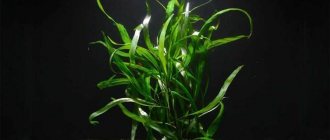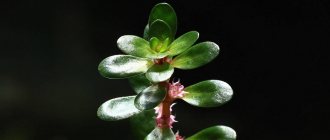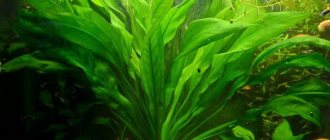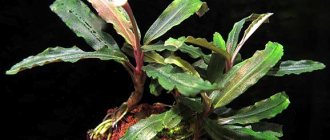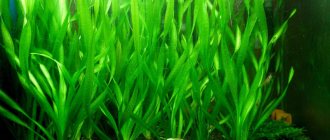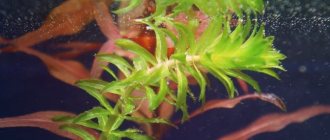5
(8)
A wide variety of plants are used to decorate an aquarium. Most often these are bushes that are planted in the ground. Depending on their size, they are placed in the background, in the center or in front. However, there are other varieties of underwater flora that, due to their shape, are not intended for planting in the substrate. Limnobium is one of these.
Description and features
Limnobium belongs to the family of aquatic plants. Its homeland is North and South America. The natural habitat of the plant is reservoirs located in subtropical and tropical zones.
This floating emergent plant is characterized by the presence of small rounded leaf blades with a glossy surface. The leaves resemble small coins, but can also be egg-shaped. The external characteristics of the 2 known varieties of Limnobium are somewhat different:
- Spongy – a weed plant with a fairly developed root system. It has a short stem and small bright green leaves. The lower part of the leaf blades has a spongy structure, which is why the plant got its name.
- Runaway – the most common variety of Limnobium among aquarists. This plant has small round leaves of rich green color, collected in a rosette. The rhizome has a fibrous structure, its length is no more than 5 cm.
The plant adapts well to changing climatic conditions. Under favorable conditions, limnobium tends to grow quickly, filling the entire surface of the reservoir. In such cases, it is recommended to remove part of the plant from time to time. It can bloom on the surface with thin, inconspicuous flowers with small petals.
Limnobium tolerates temperature fluctuations well.
The optimal temperature for the full development of the plant is 20-+30°C.
In cooler water, Limnobium growth slows down significantly. This aquarium plant reproduces using shoots, at the ends of which daughter shoots are formed.
First steps after purchase
New Limnobium, like any aquarium plant, is carefully inspected for the presence of rot or visible pests. If necessary, treat with antiseptic solutions. The simplest and most affordable option is a weak 0.1% solution of potassium permanganate; you can also place the plant in a 0.01% solution of Buprofezin for 2 hours. Parts of Limnobium damaged during transportation should be removed immediately. After this, the shoots of the plant, which already have leaves and roots, are simply placed on the surface of the water, providing the beginner with additional illumination with fluorescent lamps for better development.
Useful properties of limnobium
Limnobium is an excellent choice for aquariums. This plant is often planted as a natural shade, protecting the pond and its inhabitants from excessive lighting. In addition, limnobium also performs a filtering function, effectively purifying the water in the aquarium from various impurities and dust.
The fibrous rhizome of the plant also absorbs particles of turbidity, silt, and various types of contaminants. In addition, limnobium and its rhizome serve as additional shelter for small aquarium fish. When grown at home and following basic care rules, the plant grows evenly throughout the year.
Riccia in nature
Amazingly, this representative of the Ricciev family can be found almost everywhere. It has filled a huge number of bodies of water with slow flowing or stagnant water in moderately warm areas around the globe.
Unpretentiousness, endurance and an original method of migration - it is this trio that underlies its wide distribution.
“Carriers” of Riccia to other bodies of water are waterfowl, to whose legs pieces of its plates stick. Even a tiny piece can give birth to a new thallus of this fast-growing moss, which rapidly fills the water surface and spreads over vast areas.
How to properly care
Limnobium belongs to the category of the simplest and most unpretentious aquarium plants to care for, which even a beginner can handle. However, for its full growth, development, and prevention of possible diseases, aquarists should pay attention to the following maintenance rules:
- Limnobium requires fairly bright lighting . The optimal length of daylight is about 12 hours. Loves natural light and looks great in the sun. For additional illumination, especially in winter, it is recommended to use fluorescent and LED light bulbs, but it is better to refrain from incandescent lamps, as they can leave pronounced burn marks on the leaf plates. It should be noted that the plant can tolerate slight shading. But, in order for the limnobium to develop well and please the eye, it is better to provide it with a sufficient amount of light.
- Water and soil quality . Limnobium is absolutely unpretentious to water quality. But experts recommend periodically changing and filtering it. In this case, you can refrain from using mineral fertilizers and other specialized fertilizers, since the plant receives all the necessary nutrients from water.
- Temperature. The plant is quite resistant to temperature changes. At temperatures below 20°C, the processes of growth and development of limnobium slow down. Too high a temperature, on the contrary, can negatively affect the condition and external characteristics of the sheet plates.
For Limnobium, the acidity of water does not matter, but its hardness should be no more than 12°C.
How to plant
The reproduction process of Limnobium occurs naturally. It is enough to create favorable conditions for this plant, including the availability of clean water, good lighting and optimal temperature conditions.
It is recommended to separate the shoots after roots and several leaf blades appear on them.
You can also plant a plant using its seeds, but they should first be saved in water, as they tend to dry out quickly. Due to the fact that Limnobium grows very actively and has a high growth rate, one representative of this species will be enough for one aquarium. Aquariums of any size are suitable for growing Limnobium.
Methods of obtaining offspring
Under favorable conditions for growth, a representative of the Vodokrasov family not only grows well, but also produces large offspring. There is no need to breed it artificially, it does everything on its own.
Periodically, buds form at the ends of short side shoots. Gradually, small leaves and fibrous roots appear from them. When there are more than three leaves, the baby is ready to separate from the mother shoot.
You can also propagate the flower by seeds, but they must be stored in water due to their tendency to dry out.
Possible difficulties
Despite Limnobium’s pickiness in terms of care, aquarists may encounter certain problems when growing it.
First of all, it is necessary to avoid placing additional lighting too close, as the lamps can cause burns that are detrimental to the plant.
You should also regularly clean the aquarium, since otherwise problems such as overgrowing of its walls and the formation of thick algae are very likely. It is strictly forbidden to sharply change water hardness levels, since this factor has an extremely negative effect on limnobium and can lead to its death.
It is undesirable to plant the plant in an aquarium next to snails and large predatory fish, as they eat its leaf plates and, most importantly, destroy the root system. Ideal neighbors for Limnobium will be small surface fish, such as gourami.
What plants does it go with?
Limnobium is not recommended to be planted together with underwater plants, due to its tendency to create shading, causing a lack of light in the latter. Climbing underwater crops are also not the best choice, as they can get tangled in the root systems of waterfowl.
Limnobium goes quite well with plants of similar shape and placement method, as well as many other types of aquarium crops. It is only important to ensure that underwater plants do not interfere with each other and are in harmony in their external qualities.
Kinds
There are different types of such aquarium plants. Let's look at some of them in more detail.
- Runaway (smooth). This variety has small leaves with a smooth and slightly shiny upper surface. One rosette usually contains up to 5 leaf blades. Her cuttings are short.
The species can easily tolerate high reservoir temperatures (up to 35 degrees), so it can be used in tropical aquariums.
- Spongy . This species has the highest growth and reproduction rates. The variety has rosettes whose diameter can reach 6-8 centimeters. This limnobium has rather short stems and petioles. The leaf blades are round in shape and have a small cut at the base. Their colors are very bright and saturated, the surface is smooth. The lower part of the leaves is ribbed.
Spongy limnobium can bloom, but its flowers are almost invisible.
Tips from experienced aquarists
Beginning aquarists who decide to grow Limnobium should pay close attention to the following recommendations from experts:
- Before replanting the plant, it must be treated with a solution of potassium permanganate and kept in a separate container for several days. This procedure will avoid possible infection of the plant, as well as strengthen its natural defense mechanisms.
- When purchasing a plant, you should carefully examine it for stains, dots, damage to the integrity of the leaf plates, and torn edges. As a rule, all this indicates the presence of pests or damage to limnobium by certain diseases characteristic of it.
- To begin with, you should not combine limnobium with a large number of other plants. The best option would be 2-3 types of aquarium crops.
- It is necessary to regularly inspect the plant, removing areas with characteristic signs of damage.
- When covering the aquarium with glass, it must be placed at an angle to prevent the formation of condensation, which, falling on the leaf plates of the limnobium, injures them.
If you follow these simple tips from professional aquarists, Limnobium will quickly grow, develop and delight the eye with its emerald green foliage.
Limnobium is a very easy-to-use, unpretentious plant that not only allows you to create an impressive aquarium design, but also performs a number of extremely useful functions. However, despite the high adaptive abilities of limnobium, it still needs to be provided with minimal care in order to protect it from pests, dangerous diseases and premature death.
